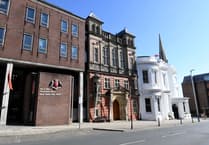An estate created by a world famous inventor, who has taken great care in designing something far from the norm, is on the market for at least £30 million.
With its elliptical form, fossil stone staircases showing creatures dating back thousands of years, 360 degree views and huge atrium, the Arragon Moar estate in Santon is certainly a stand-out property.
’It’s fun creating something that’s unique in the world, as it’s never been done before,’ said owner Dr John Taylor OBE - most famous for his invention of a thermostat control that switches off a kettle once it starts boiling to stop it from boiling dry.
challenge
The Buxton-born man not only enjoys a challenge, but has a clear appreciation of nature and history having named his six-bedroom property after a 5,000-year-old Neolithic quartz circle that rests on the estate.
It took seven years to build the estate, which was completed in 2014 at a cost of £23 million. The property is also wheelchair-friendly with the late Professor Stephen Hawking being welcomed as a guest there when visiting the island.
Having designed five other houses previously, Dr Taylor had asked himself ’what can I do that nobody’s done before?’ when purchasing the Santon plot of land covering some 280 acres. Basing a lot of his work on the classical English Palladian architecture, he created the 20,000 sq ft country house in elliptical form - the shape of an oval.
Dr Taylor said: ’I never like to do what other people have done before, a round house would have been too easy.’
The unconventional shape of the property led to Dr Taylor making clever features, such as the railings throughout the house paying tribute to the house’s overall oval shape.
The wrought-iron Chinese dragons guarding the entrance of the building have been moulded to fit the exterior of the building.
’The whole building is curved and the dragons have been curved to fit. This is the detail I enjoy making right,’ he said. He added that if he had not tried to make the dragons hug the red sandstone walls, ’nobody, probably, would have noticed... but I would’.
The best view to truly appreciate the elliptical shape is from the top floor looking into the vast atrium where his Chronophage, ’time-eater’ in Greek, sits on the wall.
This invention has another Chinese dragon on top, which interacts with its audience, and gives a different approach to telling the time.
Out on to the roof terrace that wraps around the copper-domed house, stunning views are provided which stretch as far as Chicken Rock Lighthouse, to North Barrule and further across the Irish Sea.
For easy access to drinks while out enjoying the views, a secret compartment within a pillar on the top floor can be found along with a fountain. This is not the only secret hideaway the building has.
Looking out on to the private land there are more than 1,000 native tree species across the estate and thousands of wild flowers.
A parterre garden in 17th century English country house style is also below with a garage concealed underneath with space for eight vehicles.
Within the centre of the parterre garden is a bronze cannon that bears the arms of French King Louis XIV and the arms of Admiral of France Le Comte De Vermandois.
This cannon was used in the Battle of Vigo in 1702 in north west Spain. It was acquired by Dr Taylor in 2009.
On site is an orangery, affectionately named ’Grandad’s Shed’ by Dr Taylor’s grandchildren.
It was built in memory of his own grandfather who was the head gardener at the Ynys-y-Maengwyn estate in Gwynedd and helped win many prizes competing against the Prince of Wales.
Marketed by Savills and Isle of Man agent Cowley Groves, the estate is available as a whole or in two lots.
Arragon Mooar is one lot with 180 acres let on an agricultural tenancy and three cottages, and Ballafurt Farm is the other with 102 acres, let on an agricultural tenancy.
Having lived in Arragon Moar, Dr Taylor would often have visiting family members stay in the individual-styled en-suite rooms that have hypoallergenic bamboo carpets.
There are also four office suites.
Dr Taylor continues to live in the island which he calls home.
He was originally drawn to the island as a boarding student at King William’s College, enjoying the freedom the island offered. He later saw it as the ideal place to bring up two children as a single parent.
’I brought them over because it’s a safe place,’ he said.




